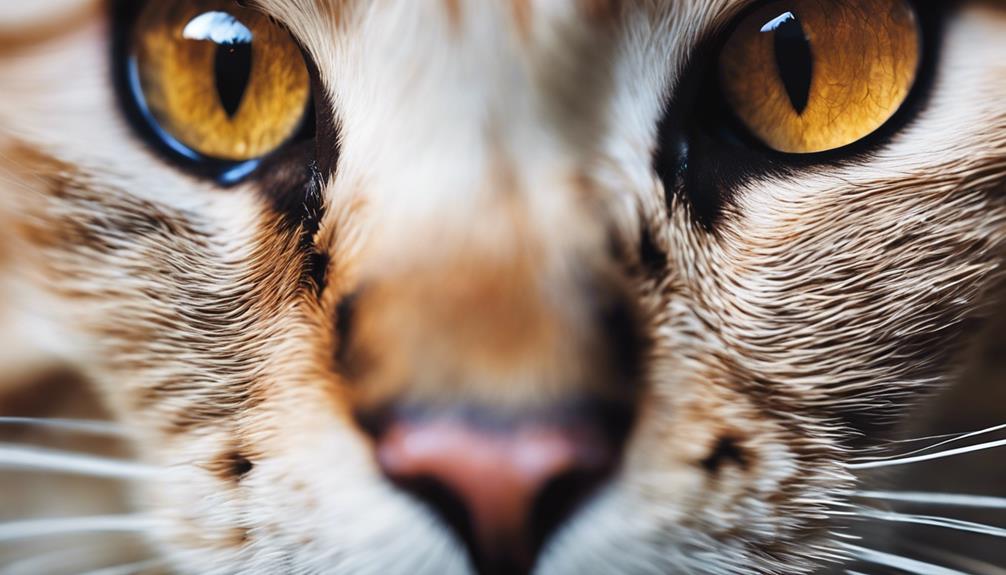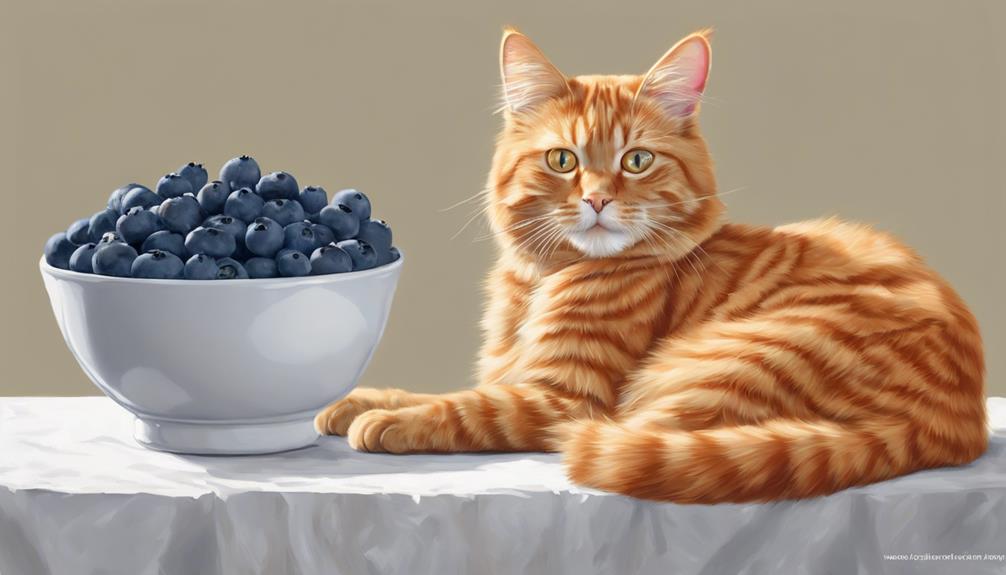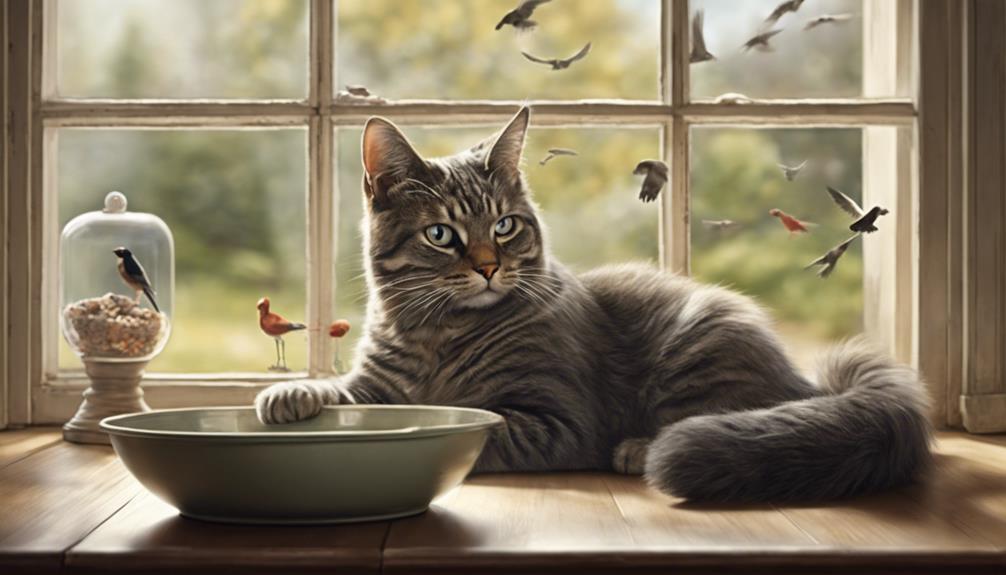Cats' ears can feel hot as they regulate body temperature by increasing blood flow. This warmth often indicates a response to heat, allergies, fever, or ear conditions. Cats naturally manage hot weather by increasing blood flow to their ears, paws, and nose, helping release excess heat. Allergic reactions, fever, and specific ear issues can also lead to warm ears in cats. Monitoring your feline's well-being is important, especially if accompanied by unusual symptoms. Understanding these causes can help you better care for your pet's health and comfort. Further insights into cat ear conditions and temperature management are essential for responsible pet ownership.
Key Takeaways
- Cats regulate body temperature by increasing blood flow to ears.
- Warm ears indicate a response to excess heat.
- Monitoring ear warmth can reflect overall well-being.
- Hot ears in cats are common in hot weather.
- Consult a vet if hot ears are accompanied by unusual symptoms.
Normal Ear Temperature Regulation
When cats regulate their body temperature, they increase blood flow to their ears. This clever mechanism helps our feline friends release excess heat, especially during warmer days. So, if you've ever felt your cat's ears and noticed they were a bit warm, don't worry – it's a normal response to temperature changes. Those toasty ears are actually a sign that your cat's body is working hard to stay cool and comfortable.
Monitoring your cat's ears for warmth is a good way to keep an eye on their overall well-being. Warm ears are usually nothing to be concerned about, but if you notice other unusual symptoms along with the warmth, it might be a good idea to consult with your vet. By paying attention to these little cues, we can help our cats stay healthy and happy, even when they're trying to beat the heat with their adorable, warm ears.
Cats Response to Hot Weather
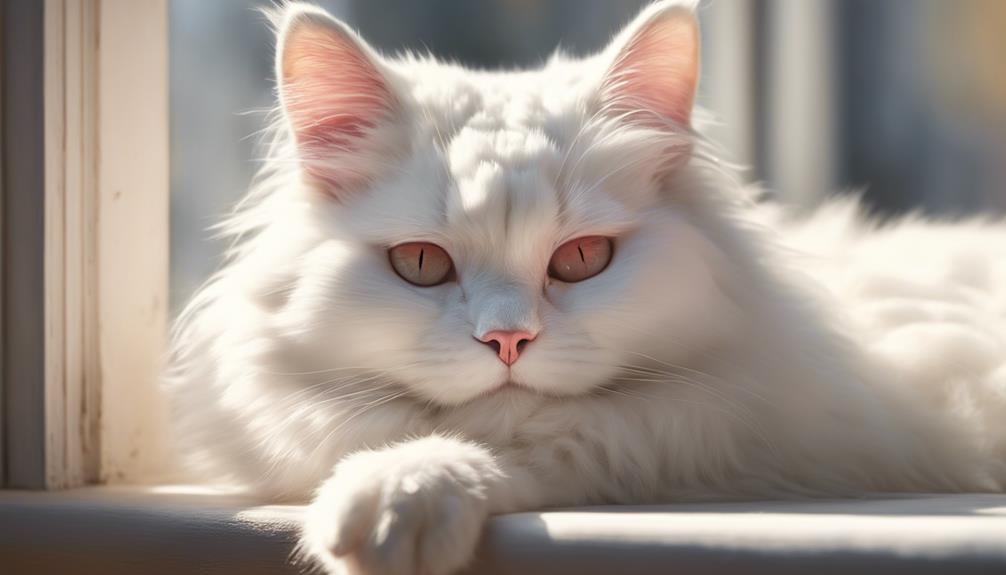
When the weather gets hot, cats have some clever ways to stay cool.
They increase blood flow to their ears, paws, and nose, allowing them to release excess heat.
Cats Heat Regulation
Cats efficiently regulate their body temperature by increasing blood flow to their ears, nose, and paws in response to hot weather. When you notice your kitty's ears feeling warm, it's their way of releasing excess heat and preventing overheating. Those toasty ears are a natural response to keep their body temperature in check.
To help your feline friend stay cool during hot weather, provide shade, plenty of water, and lend a hand with grooming. By ensuring these simple measures, you can assist your cat in managing the heat and keeping their ears at a comfortable temperature.
Sun Exposure Effects
In scorching weather, feline companions respond to sun exposure by utilizing their ears, paws, and nose to regulate body temperature efficiently. When cats are exposed to the sun's rays, their ears may feel warm as increased blood flow helps release excess heat from their bodies. This natural response aids in cooling them down during hot weather. Providing shade, water, and grooming assistance can further assist cats in managing their body temperature. Here is a helpful table to understand how cats respond to sun exposure:
| Response | Description |
|---|---|
| Warm Ears | Increased blood flow aids in heat release |
| Paws and Nose | Also involved in regulating body heat |
| Grooming Assistance | Helps cats cool down and maintain comfort |
Behavior in Heat
Responding to high temperatures, feline companions exhibit distinct behaviors to cope with the heat and regulate their body temperature efficiently. Cats regulate their body temperature by increasing blood flow to their ears, paws, and nose when the weather gets hot. This increased blood flow helps them release excess heat, and you might notice their ears feeling warm. It's a vital response to aid in cooling their bodies.
To help your cat stay cool and prevent overheating during hot weather, provide shade, plenty of water, and grooming assistance. Monitoring your cat's behavior is essential, as extreme heat can be dangerous for them. By understanding their cooling mechanisms and taking proper care, you can make sure your furry friend stays comfortable even in the hottest weather.
Allergic Reactions and Hot Ears

Experiencing allergic reactions can often result in cats having hot ears as a noticeable symptom. When our furry friends come into contact with allergens like pollen or grass, their immune system can react, leading to symptoms such as bloating, sneezing, and those telltale hot ears. If you notice your cat's ears feeling warm, it could be a sign of an allergic reaction. Fortunately, allergy testing can pinpoint the specific allergen triggering this response, helping us find effective solutions for managing hot ears in cats.
To provide clarity on allergic reactions and hot ears in cats, here is a helpful table outlining key points:
| Topic | Description | Importance |
|---|---|---|
| Allergens | Pollen, grass, insects, certain foods | Identifying triggers |
| Symptoms | Bloating, sneezing, hot ears | Indicating allergies |
| Allergy Testing | Pinpoint specific allergen causing hot ears | Tailored treatment |
Understanding these aspects can assist in addressing allergic reactions and keeping our feline companions comfortable and healthy.
Fever Indications in Cats

After discussing how hot ears in cats can be a sign of allergic reactions, we now shift our focus to identifying fever indications in felines. Fever in cats is often accompanied by a range of symptoms that can help you recognize when your furry friend might be feeling under the weather. Signs of fever include lethargy, reduced appetite, and behavioral changes.
If you suspect your cat might've a fever, it's crucial to check their temperature. Using a rectal thermometer is the most accurate way to measure a cat's temperature, as their ears feeling warm alone may not provide an accurate reading. Remember, a cat's normal temperature ranges from 101° to 102.5°F.
If your cat's temperature is persistently above 104°F, seek immediate veterinary care to address any underlying issues. Keeping an eye out for these indications and promptly seeking veterinary attention when needed can help guarantee your cat stays healthy and happy.
Troublesome Ear Mites

Ear mites, tiny parasites that cause intense itching and discomfort in cats, can be a troublesome issue for feline health. These pesky parasites not only irritate your furry friend but can also lead to more severe problems if left untreated.
Here are some key points to keep in mind about ear mites:
- Symptoms: Look out for dark discharge resembling coffee grounds in your cat's ears, indicating a possible ear mite infestation.
- Medication: It's important to consult a vet for proper medication to effectively treat ear mites and provide relief to your cat.
- Contagious: Ear mites are highly infectious and can easily spread to other pets or even to you if not managed promptly.
- Treatment: Prompt intervention is essential to prevent the infestation from worsening and causing discomfort to your beloved pet.
Potential Ear Infections
Ear infections in cats can cause their ears to feel warm to the touch. Signs of an infection may include redness, discharge, or a foul odor.
Treatment options typically involve medications prescribed by a veterinarian.
Signs of Infection
Frequent scratching or pawing at a cat's ears may be an indication of discomfort or pain associated with a potential ear infection. When observing your feline friend, keep an eye out for these signs of infection:
- Redness in the ear canal
- Swelling around the ear area
- Foul odor emanating from the ears
- Discharge, crustiness, or black debris inside the ears
If you notice any of these symptoms, it's crucial to seek immediate veterinary attention for your cat. Ear infections can lead to further complications like head shaking, tilting, and hearing loss if left untreated. By addressing these signs promptly, you can make certain your cat receives the necessary care to alleviate their discomfort and prevent potential complications.
Treatment Options
Upon diagnosing a potential ear infection in cats, various treatment options are available to address the underlying causes and alleviate discomfort. Seeking prompt veterinary attention is essential to guarantee the correct treatment plan for your feline companion. Treatment for ear infections may involve the use of antibiotics to combat bacterial infections, antifungal medications for yeast-related issues, or gentle ear cleaning to remove debris and excess wax. Ignoring ear infections can lead to serious complications, such as hearing loss in cats, underscoring the importance of timely intervention. Below is a table summarizing the common treatment options for ear infections in cats:
| Treatment Options | Description |
|---|---|
| Antibiotics | Combat bacterial infections in the ear canal |
| Antifungal Medications | Treat yeast-related ear infections |
| Ear Cleaning | Remove debris and excess wax from the ear canal |
Understanding Cats Body Temperature

Understanding how cats regulate their body temperature is crucial for their overall health and well-being. Cats have a higher normal body temperature range of 101° to 102.5°F compared to typical human body temperature. When you feel warm cat ears, it's because blood flow increases to help release excess heat. This natural mechanism is essential for keeping your feline friend comfortable and healthy.
Cats have a higher normal body temperature range of 101° to 102.5°F compared to humans.
Feeling slightly warm ears in cats is normal due to their elevated body temperature.
Cats' ears help regulate body temperature by increasing blood flow to ears, paws, and nose.
Warm ears in cats during hot weather is a natural response to help release excess heat.
Understanding these aspects of your cat's body temperature can help you better care for them and make sure they stay happy and healthy.
Identifying Fever in Cats
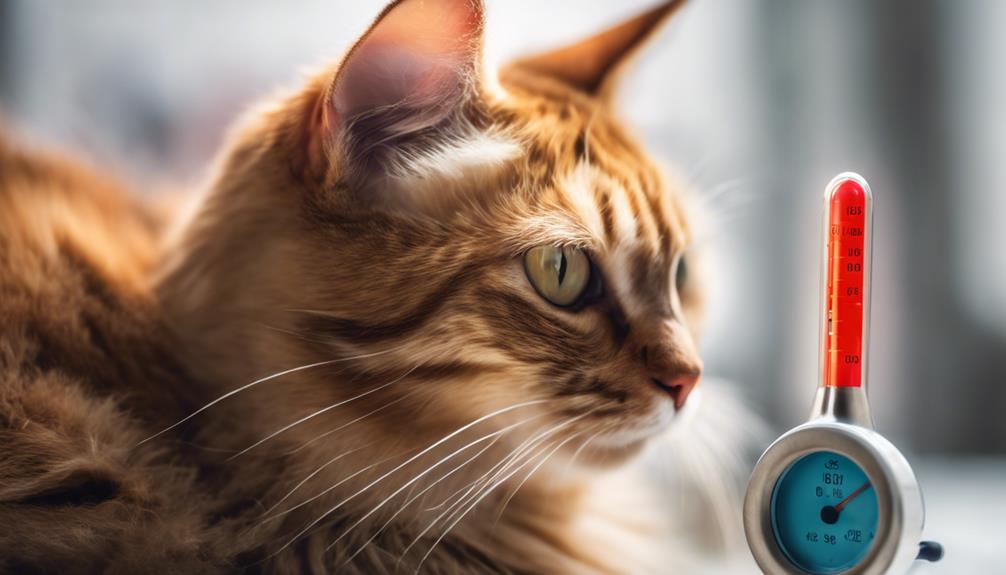
False
Signs of Elevated Temperature
Spotting signs of elevated temperature, such as lethargy and loss of appetite, can help identify fever in cats. When observing your feline friend, look out for these key indicators:
- Lethargy: If your cat is unusually tired or less active than usual, it could be a sign of fever.
- Loss of Appetite: Refusing food or eating noticeably less might indicate an elevated temperature.
- Shivering: Trembling or shivering, especially if accompanied by other symptoms, could be a sign of a fever.
- Checking Body Warmth: Feel the stomach and underarms for unusual warmth, which might suggest a fever.
Monitoring Body Temperature
To accurately monitor a cat's body temperature and identify fever, feeling the ears for warmth can be a valuable indicator. A cat's normal body temperature typically falls between 101° to 102.5°F.
Hot ears in cats may signal a fever, especially when coupled with behavioral changes, lethargy, or reduced appetite. While warm ears alone don't definitively confirm a fever, they can prompt further investigation.
Using a rectal thermometer is the most precise method to check a cat's temperature, with anything above 103°F considered important. If you suspect your feline friend has a fever, it's essential to seek prompt veterinary care.
Your vet can provide guidance on monitoring body temperature and managing fevers in cats effectively.
Dealing With Allergies in Cats

Dealing with allergies in cats requires identifying and addressing the specific irritants that trigger allergic reactions in feline companions. Allergies in cats can be caused by various irritants like pollen, grass, insects, and certain foods. When your cat shows symptoms such as sneezing, wheezing, watery eyes, or excessive licking, it's important to take into account the possibility of allergies. Seeking veterinary care for allergy testing is necessary to pinpoint the exact allergen affecting your cat.
Once the allergen is identified, managing and treating allergic reactions can be done effectively. Here are some strategies for dealing with allergies in cats:
- Consider using antihistamines to alleviate symptoms.
- Allergy shots can help desensitize your cat to specific allergens.
- Making dietary changes may reduce allergic reactions.
- Regular veterinary care and monitoring are essential to guarantee your cat's health and well-being.
Addressing Ear Mite Infestations
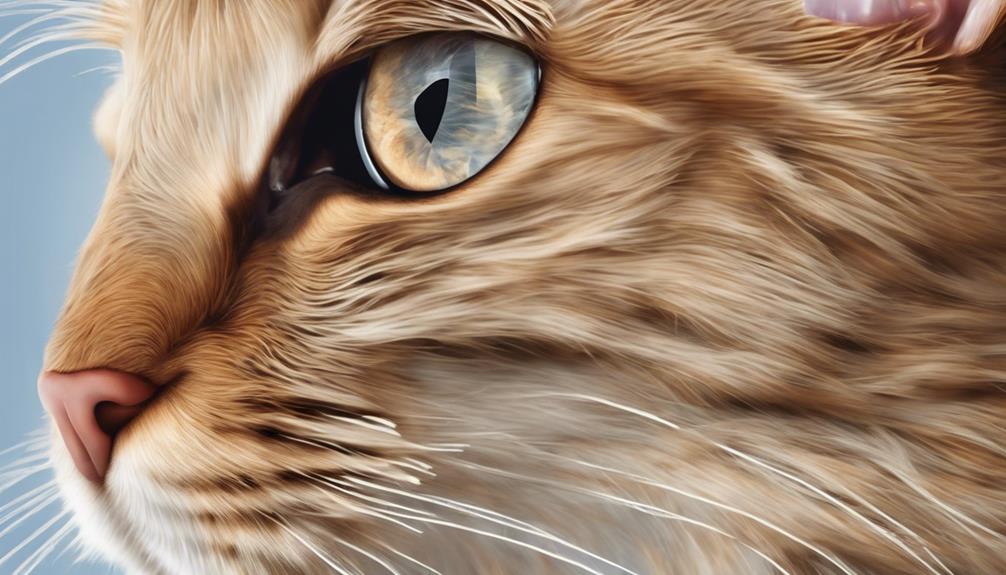
When addressing ear mite infestations in cats, it's essential to identify the symptoms, such as excessive scratching and dark discharge in the ears.
Treatment for ear mites typically involves medication prescribed by a veterinarian, and regular cleaning is vital for preventing further issues.
Identifying Ear Mites
Identifying ear mites in cats involves closely examining the ear canal for dark discharge resembling coffee grounds. When dealing with ear mites, it's vital to pay attention to the following signs:
- Presence of dark discharge in the ear canal
- Itching and discomfort exhibited by the cat
- Inflammation and heat in the ears
- Potential for secondary infections if left untreated
If you notice these symptoms, it's important to seek prompt attention from a veterinarian. Professional treatment is necessary to effectively eliminate ear mites and prevent further discomfort for your feline friend. Remember, addressing ear mite infestations promptly can help safeguard your cat's ear health and overall well-being.
Treating Ear Mite Infections
To effectively address ear mite infestations in cats, prompt veterinary intervention with proper medication is vital. When a cat has hot ears or if you notice dirty, highly contagious ear mites, seeking medical help promptly is imperative. Ear mites can spread quickly, causing discomfort and potential ear infections.
Over-the-counter treatments may not be effective against these pesky parasites. A veterinarian will be able to diagnose the issue accurately and prescribe the appropriate medication to treat the infestation. Remember, ear mites are highly contagious, so it's crucial to address the problem promptly to prevent it from spreading to other pets or even to humans.
Managing Cat Ear Infections
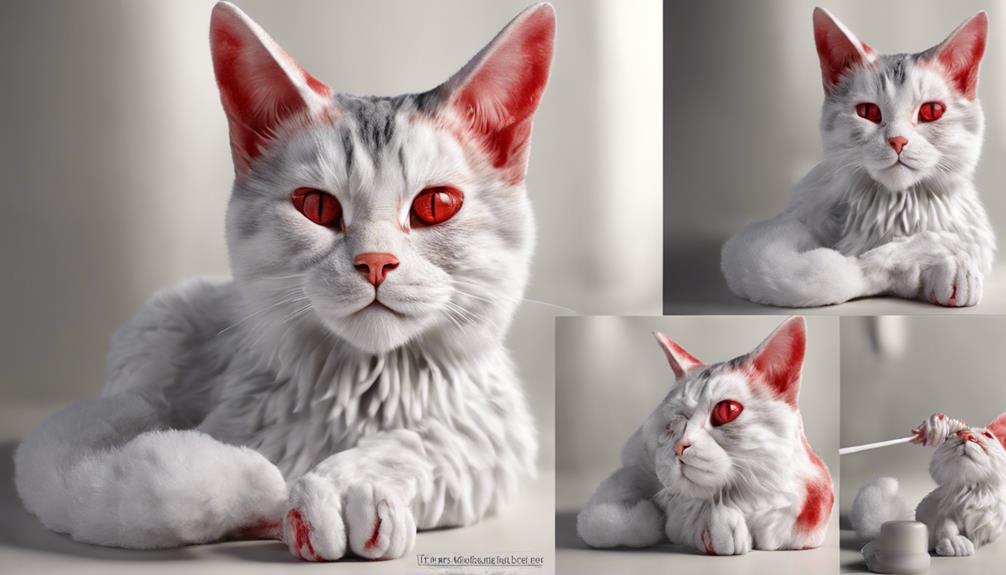
One essential aspect in caring for cats is effectively managing ear infections caused by bacteria, yeast, or ear mites.
When dealing with cat ear infections, it's important to take into account the following:
- Symptoms: Keep an eye out for signs like pain, head shaking, and altered balance, which could indicate an ear infection.
- Complications: Untreated infections can lead to serious issues, including hearing loss, so immediate attention is vital.
- Veterinary Attention: Seeking immediate help from a vet is essential for accurate diagnosis and appropriate treatment.
- Treatment: Treatment options may include antibiotics, antifungal medications, and regular ear cleaning to address the infection.
Cats Natural Temperature Control

Cats naturally regulate their body temperature by increasing blood flow to their ears, paws, and nose. When you notice your cat's ears feeling warm, it's often a sign of this natural temperature control mechanism at work. Increased blood flow to the ears helps your feline friend release excess heat, especially when the environmental temperature changes.
Those cute, warm ears aren't just adorable but also crucial for your cat's well-being. The veins in their ears expand when it's warm to allow heat to escape and constrict when it's cold to maintain heat within the body. By understanding how cats use their ears to manage body temperature, you can guarantee they stay comfortable and healthy.
Signs of Fever in Cats

When a cat's body temperature rises above 103.5°F, it indicates the presence of a fever. Signs of fever in cats may include:
- Lethargy, where your feline friend seems unusually tired and less active than usual.
- Loss of appetite, as cats with fevers often show a decrease in their interest in food.
- Shivering, where your cat may tremble or shake involuntarily in response to the increased body temperature.
- Using a rectal thermometer is the most accurate way to check your cat's temperature and confirm the presence of a fever.
If your cat's fever persists above 104°F, it's important to seek immediate veterinary attention. Additionally, isolating behavior and a change in appetite can also be indicators of fever in cats.
Monitoring your cat's body temperature and being attentive to these signs can help you detect a fever early and make sure your furry companion receives the necessary care promptly.
Coping With Allergies in Cats
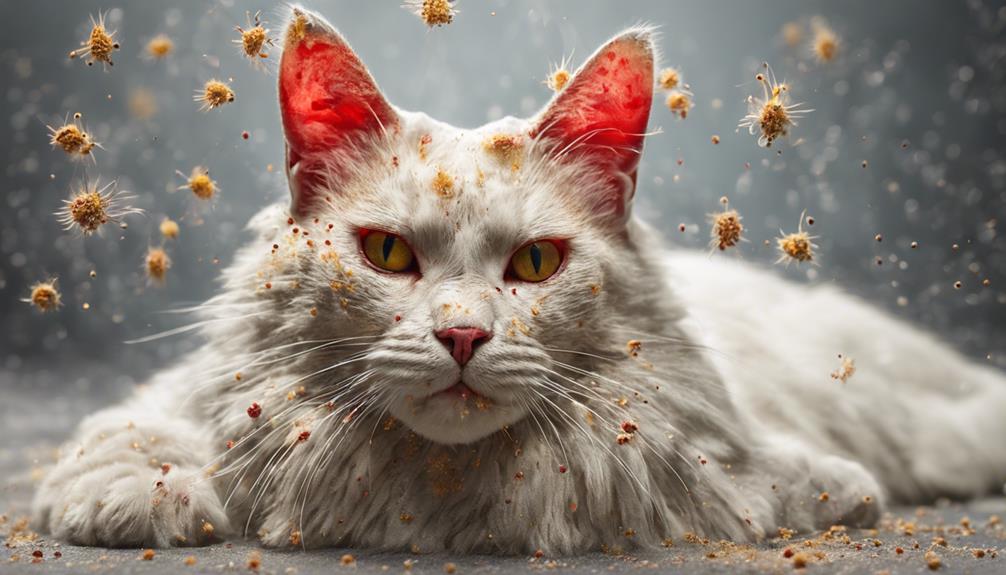
To address allergies in cats, understanding common triggers like pollen, grass, insects, and certain foods is vital for effective management. Cats with allergies may exhibit symptoms such as bloating, sneezing, wheezing, watery eyes, and hot ears.
If you notice your feline friend excessively licking their ears, it could be a sign of allergies affecting them. It's important to consult a veterinarian for allergy testing to pinpoint the specific irritants causing reactions in your cat.
By identifying the allergens, you can then explore effective solutions like antihistamines to help manage your cat's allergies and provide them with relief. Remember, each cat may react differently to various allergens, so tailored approaches based on allergy testing results are key to finding the best way to cope with your cat's allergies.
Remedies for Ear Mite Problems
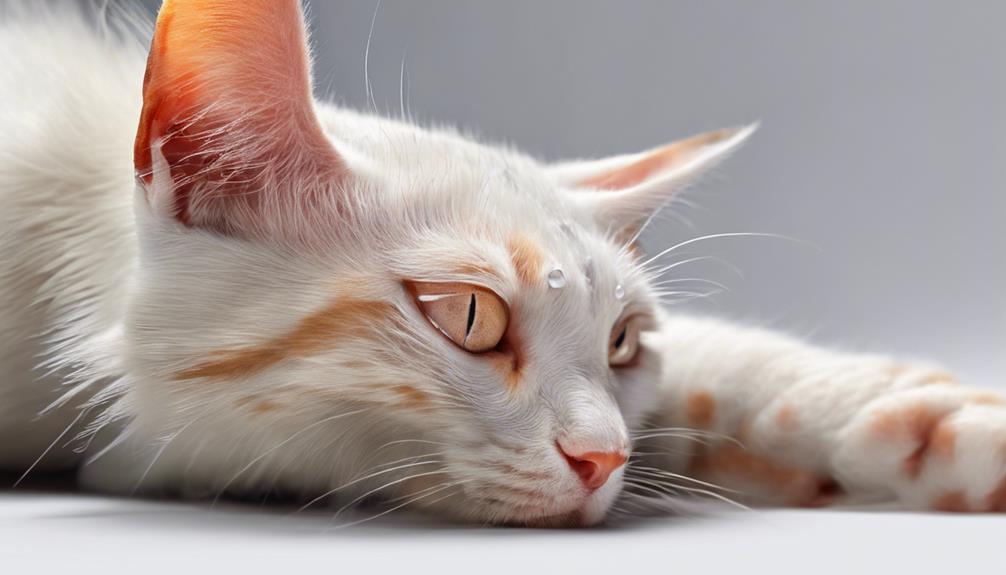
Upon noticing symptoms of ear mite infestation in your pet, seeking proper medication from a vet is essential for effective treatment. Ear mites are tiny parasites that cause intense itching and discomfort in cats. Symptoms of ear mite infestation include dark discharge resembling coffee grounds in the ears. If left untreated, ear mites can spread to other pets and even humans, highlighting the importance of prompt intervention.
While over-the-counter remedies may be available, they may not provide adequate treatment for ear mites in cats.
- Seek proper medication from a vet for effective treatment.
- Watch out for symptoms like dark discharge in the ears.
- Remember that ear mites can spread to other pets and humans if left untreated.
- Be cautious with over-the-counter remedies, as they may not offer sufficient relief for ear mite problems in cats.
Taking swift action and following the vet's advice can help alleviate your cat's discomfort and prevent the spread of ear mites.
Frequently Asked Questions
Should I Be Worried if My Cats Ears Are Hot?
If our cats' ears feel hot without other concerning signs, it might not be worrisome. Still, we suggest monitoring. Hot ears can be normal for temperature regulation. But if in doubt, consulting a vet is wise.
What Are the Symptoms of Fever in Cats?
When cats have a fever, they might show signs like lethargy, loss of appetite, and shivering. It's important to keep an eye out for unusual warmth in their belly and underarms. A fever above 104°F demands immediate vet care.
Why Does My Cats Ear Look Burnt?
Our cat's ear may look burnt due to excessive sun exposure causing sunburn. This can lead to redness, peeling, and discomfort. Protecting their ears with shade, sunscreen, or hats can prevent burns. Consult a vet if concerned.
Why Does My Cat's Head Feel Warm?
When our cat's head feels warm, it may indicate various issues like fever, infections, or even just the body regulating temperature. Monitoring for other symptoms is essential. If concerned, consulting a vet promptly is wise.
Conclusion
To summarize, when your cat's ears feel hot, it could be due to a variety of reasons such as hot weather, allergic reactions, fever, or ear mites. Monitoring your cat's temperature and behavior is essential for their health and well-being.
Remember, just like us, cats have their ways of regulating their body temperature. So, keep an eye out for any signs of discomfort and consult your veterinarian if needed.
Stay cool, cat lovers!
